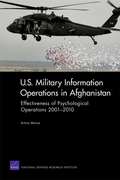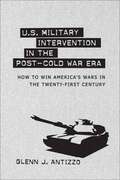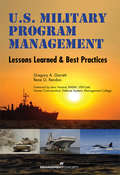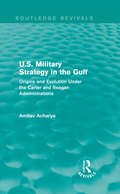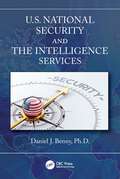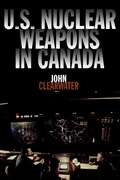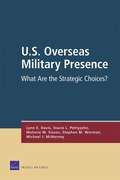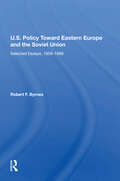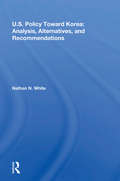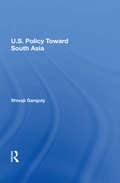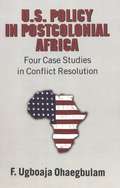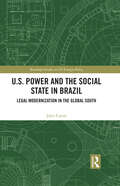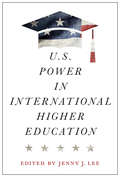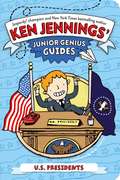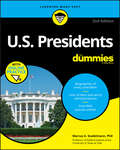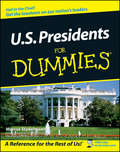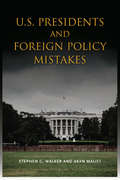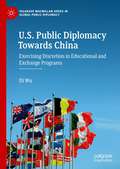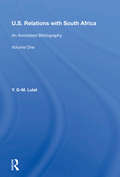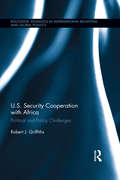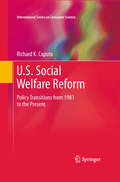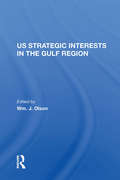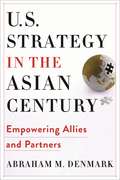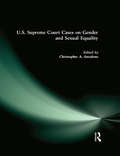- Table View
- List View
U.S. Military Information Operations in Afghanistan: Effectiveness of Psychological Operations 2001-2010
by Arturo MunozThe U. S. Marine Corps, which has long recognized the importance of influencing the civilian population in a counterinsurgency environment, requested an evaluation of the effectiveness of thepsychological operations element of U. S. military information operations in Afghanistan from 2001 to 2010 based on how well messages and themes were tailored to target audiences. This monograph responds to that request.
U.S. Military Intervention in the Post-Cold War Era: How to Win America's Wars in the Twenty-first Century (Political Traditions in Foreign Policy Series)
by Glenn J. AntizzoDuring the post--World War II era, American foreign policy prominently featured direct U.S. military intervention in the Third World. Yet the cold war placed restraints on where and how Washington could intervene until the collapse of the former Soviet Union removed many of the barriers to -- and ideological justifications for -- American intervention. Since the end of the cold war, the United States has completed several military interventions that may be guided by motives very different from those invoked before the collapse of the Berlin Wall. Likewise, such operations, now free from the threat of counterintervention by any other superpower, seem governed by a new set of rules.In this readily accessible study, political scientist Glenn J. Antizzo identifies fifteen factors critical to the success of contemporary U.S. military intervention and evaluates the likely efficacy of direct U.S. military involvement today -- when it will work, when it will not, and how to undertake such action in a manner that will bring rapid victory at an acceptable political cost. He lays out the preconditions that portend success, among them a clear and attainable goal; a mission that is neither for "peacekeeping" nor for "humanitarian aid within a war zone"; a strong probability the American public will support or at least be indifferent to the effort; a willingness to utilize ground forces if necessary; an operation limited in geographic scope; and a theater commander permitted discretion in the course of the operation. Antizzo then tests his abstract criteria by using real-world case studies of the most recent fully completed U.S. military interventions -- in Panama in 1989, Iraq in 1991, Somalia in 1992--94, and Kosovo in 1999 -- with Panama, Iraq, and Kosovo representing generally successful interventions and Somalia an unsuccessful one. Finally, he considers how the development of a "Somalia Syndrome" affected U.S. foreign policy and how the politics and practice of military intervention have continued to evolve since the terrorist attacks of September 11, 2001, giving specific attention to the current war in Afghanistan and the larger War on Terror. U.S. Military Intervention in the Post--Cold War Era exemplifies political science at its best: the positing of a hypothetical model followed by a close examination of relevant cases in an effort to provide meaningful insights for future American international policy.
U.S. Military Program Management: Lessons Learned and Best Practices
by Gregory A. Garrett PMP Rene G. Rendon PMPAn indispensable resource for all defense industry professionals—governmental and commercial!Introducing the only book on the market offering valuable best practices and lessons learned for U.S. military program managementThe U.S. Department of Defense and the related defense industry together form the largest and most powerful government and business entity in the world, developing some of the most expensive and complex major systems ever created.U. S. Military Program Management presents a detailed discussion, from a multi-functional view, of the ins and outs of U.S. military program management and offers recommendations for improving practices in the future. More than 15 leading experts present case studies, best practices, and lessons learned from the Army, Navy, and Air Force, from both the government and industry/contractor perspectives.This book addresses the key competencies of effective U.S. military program management in six comprehensive sections:• Requirements management• Program leadership and teamwork• Risk and financial management• Supply chain management and logistics• Contract management and procurement• Special topics
U.S. Military Strategy in the Gulf: Origins and Evolution Under the Carter and Reagan Administrations (Routledge Revivals)
by Amitav AcharyaFirst published in 1989, this title explores the nature and dimensions of the U.S. strategy in the Gulf in the formative years that followed the fall of the Shah, the Soviet invasion of Afghanistan and the outbreak of the Iran-Iraq war. It describes the formation of the U.S. Rapid Deployment Joint Task Force and the U.S. Central Command, their force structure and the network of U.S. bases and facilities in the region. The role of pro-Western countries in the wider region, in particular Pakistan, Egypt, Jordan, and Israel, in the formulation of strategy is discussed in detail, along with a more general assessment of the achievements and failures of U.S. strategy in the Gulf towards the end of the 1980s. In light of the persistent struggle for peace within the Middle East, this is a timely reissue, which will be of great interest to students researching U.S. military strategy over the past thirty years.
U.S. National Security and the Intelligence Services
by Daniel J. BennyWhile there are books that cover national security, intelligence collection, intelligence analysis, and various intelligence services, U.S. National Security and the Intelligence Services is the first, all-inclusive book to examine intelligence agencies as a direct function of national security. It serves as a comprehensive text for students and a resource for those in the intelligence profession and national security scholars. The book offers an in-depth understanding of the important role that the intelligence services provide to the national security of a nation. It also includes information on the various types of intelligence, collection methods, tradecraft and intelligence analysis methods, as well intelligence-related resources. Coverage provides an overview of what national security is and its relationship to intelligence services of the United States, its key allies, and hostile nations. Key Features: Identifies the various national security threats and details the numerous U.S. and key allied intelligence services that work and collaborate to mitigate such threats Reviews the types of intelligence—outlining intelligence collection methods and intelligence tradecraft Explores how to determine the value of the intelligence collected, explaining the various methods of intelligence analysis and optimal methods to present conclusions The roles the various agencies in the intelligence services play are as vital as the intelligence collected, the means by which it’s collected, and the methodology in which it is disseminated and analyzed. U.S. National Security and the Intelligence Services provides a handy reference outlining the framework, and the processes, that comprise the US intelligence apparatus.
U.S. Nuclear Weapons in Canada
by John ClearwaterIn this second volume of his nuclear weapon series, John Clearwater continues to investigate the presence of American nuclear weapons in Canada. In Canadian Nuclear Weapons, Clearwater told the story of nuclear weapons that were in the hands of Canadian forces during the Cold War. In U.S. Nuclear Weapons in Canada, he goes further, looking at nuclear weapons held by American forces on Canadian soil. His purpose is to bring together until-recently secret information about the nature of the nuclear weapons stored, stationed, or lost in Canada by the United States Air Force and the United States Navy, and combines it with known information about the systems in the U.S. nuclear arsenal.The history of the atomic bomb in Canada goes back to the first years immediately after World War II when the U.S. government, under the prodding of the newly created Strategic Air command, began a slow and steady process of talks designed to allow Goose Bay to be groomed for the eventual acceptance of nuclear weapons.Crashes and nuclear accidents. Conspiracies and cover-ups. Clearwater examines them all in great detail. The reader will see for the first time the minutes of Cabinet and the Cabinet Defence Committee meetings in which the storage of nuclear weapons are discussed. Also printed here for the first time are the agreements between Canada and the U.S. for the storage of nuclear weapons. Many of the documents presented here were until recently classified as secret, and many were top secret.
U.S. Overseas Military Presence: What Are the Strategic Choices?
by Lynn E. Davis Stacie L. Pettyjohn Melanie W. Sisson Stephen M. Worman Michael J. McnerneyThe role of the United States and its global military presence are under debate in the face of changing strategic and economic realities. The authors present a menu of global postures and compare them in terms of the U. S. Air Force bases, combat forces, active-duty personnel, and base operating costs. Ultimately, the choice will depend on perspectives on the role overseas military presence can play in achieving U. S. global security interests.
U.S. Policy Toward Eastern Europe And The Soviet Union: Selected Essays, 1956-1988
by Robert F. ByrnesThis volume consists of a collection of essays written by Professor Byrnes between 1956 and 1988. The papers vary considerably in focus and include policy issues that were significant at the time, with the Cold War analyses around the post-war containment theory. In addition, there is a consistent viewpoint and argument in Byrnes reflections on East-West relations. A central theme throughout the collection is the essential correctness of U.S. foreign policy toward the Soviet Union and Eastern Europe between 1946 and 1988.
U.S. Policy Toward Korea: Analysis, Alternatives, And Recommendations
by Nathan N. WhiteDr. White formulates four major alternatives for U.S. policy toward South Korea, reflecting the spectrum of options available and ranging from disengagement to continued support, encouragement of peaceful unification with the north, and legitimization of the status quo. He presents and evaluates a case for each alternative, then offers a judgment a
U.S. Policy Toward South Asia
by Shivaji GangulyFor over 40 years the United States has vacillated between interventionism and withdrawal while struggling to formulate a coherent policy toward South Asia. The author has written an analysis of how Washington determines its South Asia policy. Situating case studies of US policy in four major South Asian crises in the broader context of Washington
U.S. Policy in Postcolonial Africa: Four Case Studies in Conflict Resolution
by Festus Ugboaja Ohaegbulam<p>This book, a concise examination of U.S. policy in contemporary Africa, delineates various aspects of the role that the U.S. played in exacerbating and/or resolving violent conflicts in postcolonial Africa and provides a succinct historical overview of these armed conflicts. F. Ugboaja Ohaegbulam devotes considerable attention to four specific conflicts in Ethiopia-Somalia, the Western Sahara, Angola, and Rwanda and to the Clinton administration's African Crisis Response Initiative and its sequel under George W. Bush. <p>The book concludes that lack of congruence between local forces in conflict in Africa, as well as U.S. aims in those conflicts, was only one of the constraints on the United States in its attempts at conflict resolution. America's counterproductive Cold War policies also defined relations with African states for far too long. Hence, the conflicts in postcolonial Africa became part of the legacy of those policies even as African problems continued to be low-priority concerns for the U.S. government. Libraries, advanced undergraduate and graduate students, and professors of African studies, as well as the general reader, will find this book useful.</p>
U.S. Power and the Social State in Brazil: Legal Modernization in the Global South (Routledge Studies in US Foreign Policy)
by Júlio CattaiThe book analyzes the elite-led efforts to transform the Brazilian legal order in the period between 1930–1975 and how U.S. Power played a major role in such a process. Besides the global circulation of ideas, the book discusses the Brazilian institutional development in the period. A profound "Crisis of Civilization" marked the first decades of the century: the references of space and time vanished with the vertiginous expansion of cities and industries, while a myriad of immigrants and former slaves were alleged to be threatening the country’s traditions. Brazilian elites blamed liberalism for such a "Crisis". Based on a decade of research, this book centralizes Brazilian history in liberalism and offers a genealogy of the jurisprudential and institutional struggles to correct the culture of laissez-faire. Using archival sources, it shows the direct U.S. influence on Brazilian thought and development. Recasting the history of legal ideas in the 20th century and providing novel interpretations on major political processes, it offers a rigorous and fresh look at the development of liberalism in the country. Covering five decades of history and offering a transnational approach involving the U.S. hegemonic role in Brazil, this book will be of interest to scholars and students of law, U.S. foreign policy, area studies and international relations.
U.S. Power in International Higher Education
by Roopa Desai Trilokekar Ellen Hazelkorn Brendan Cantwell Jenny J. Lee Gerardo L. Blanco John P. Haupt Chrystal A. Mwangi Sean Jung-Hau Chen Pempho Chinkondenji Dale LaFleur Christina W. Yao Chris R. Glass Sharon Stein Santiago Castiello-GutiérrezU.S. Power in International Higher Education explores how internationalization in higher education is not just an educational endeavor, but also a geopolitical one. By centering and making explicit the role of power, the book demonstrates the United States’s advantage in international education as well as the changing geopolitical realities that will shape the field in the future. The chapter authors are leading critical scholars of international higher education, with diverse scholarly ties and professional experiences within the country and abroad. Taken together, the chapters provide broad trends as well as in-depth accounts about how power is evident across a range of key international activities. This book is intended for higher education scholars and practitioners with the aim of raising greater awareness on the unequal power dynamics in internationalization activities and for the purposes of promoting more just practices in higher education globally.
U.S. Presidents (Ken Jennings’ Junior Genius Guides)
by Ken JenningsBecome a presidential pro with this interactive trivia book from Jeopardy! champ and New York Times bestselling author Ken Jennings.With this book about U.S. Presidents, you’ll become an expert and wow your friends and teachers with clever facts: Did you know that Abraham Lincoln made Thanksgiving a national holiday? Or that Jefferson introduced the first French fries at a fancy state dinner? With great illustrations, cool trivia, and fun quizzes to test your knowledge, this patriotic genius guide will have you on your way to whiz-kid status in no time!
U.S. Presidents For Dummies
by Marcus A. StadelmannDiscover how the Oval Office’s occupants have made and make history Which one was the tallest? Which one fought a duel? Which had liquor smuggled into the White House during Prohibition? And why is the president even called the president in the first place? From periwigs and knee breeches to the 24-hour news cycle and presidential Tweets, the fascinating and colorful stories of the 45 incumbents are a powerful lens through which to view U.S. history and get insight into the present. Taking readers on a fact-filled journey through two centuries, this book examines how each individual obtained their dream (or nightmare) position, what they stood for (or against), achieved (or didn’t), and how their actions affected the country—for better or worse. And—remembering that presidents are people too—it shows how the personal really can be political, exploring how each president’s vision, strengths, and foibles helped or hindered them in building the country and their own legacy. Accessible biographies of all presidents Sidebars, timelines, and photos Lists of best and worst administrations Bonus online content, including quizzes galore to help build retention Whether you’re a student, a history buff—or are even interested in becoming president yourself one day—U. S. Presidents For Dummies is the perfect guide to what it takes to be leader of the free world, who has stepped up to that challenge, and how those personal histories can help us understand yesterday’s, today’s, and even tomorrow’s union.
U.S. Presidents For Dummies (For Dummies Ser.)
by Marcus A. StadelmannForty-three Americans have held the job of President of the United States. Each has a story, be it one of vision, accomplishment, conflict, scandal, triumph, or tragedy. And each story is at the center of the national story, a part of what we all experience. History buffs find endless fascination – and a greater understanding of America today – in the colorful personalities and momentous events that surround the Oval Office. If you want the complete take on U. S. presidents, from George Washington to George W. Bush, you’ll appreciate U. S. Presidents for Dummies. Written in a lively style by a history professor at the University of Texas, this fun guidebook of chief executives is packed with information, factoids, and memorable quotes. Inside, you’ll find out which president: Promised to only serve one term, and kept his word! Was a great person but a rotten president Campaigned on nothing but image – in the n ineteenth century! May be the most underrated president in history Had his own distributor bringing liquor to the White House – during Prohibition! Appointed the first female cabinet member Pushed through the first civil rights legislation after the end of the Civil War Said of himself, “I am a man of limited talents from a small town. I don’t seem to grasp that I am president” U. S. Presidents for Dummies offers a wealth of knowledge on what it takes to be the leader of the free world, and who has stepped up to the challenge. Dividing the ranks of presidents into chronological groups for a broader, historical understanding of the office, this book discusses: The birth and evolution of the presidency Ineffective presidents Forgettable presidents Working up to the Civil War Reconstruction presidents Becoming a force in the world Instituting the Imperial Presidency Today’s changing dynamics and the Presidency A treasury of information, this book features an easy-to-comprehend style and sharp historical analysis. Sidebars, photos, timelines, and best and worst lists make U. S. Presidents for Dummies a historical blast to read and a must-have for understanding the state of both yesterday’s and today’s union.
U.S. Presidents For Dummies with Online Practice
by Marcus A. StadelmannDiscover how the Oval Office’s occupants have made and make history Which one was the tallest? Which one fought a duel? Which had liquor smuggled into the White House during Prohibition? And why is the president even called the president in the first place? From periwigs and knee breeches to the 24-hour news cycle and presidential Tweets, the fascinating and colorful stories of the 45 incumbents are a powerful lens through which to view U.S. history and get insight into the present. Taking readers on a fact-filled journey through two centuries, this book examines how each individual obtained their dream (or nightmare) position, what they stood for (or against), achieved (or didn’t), and how their actions affected the country—for better or worse. And—remembering that presidents are people too—it shows how the personal really can be political, exploring how each president’s vision, strengths, and foibles helped or hindered them in building the country and their own legacy. Accessible biographies of all presidents Sidebars, timelines, and photos Lists of best and worst administrations Bonus online content, including quizzes galore to help build retention Whether you’re a student, a history buff—or are even interested in becoming president yourself one day—U. S. Presidents For Dummies is the perfect guide to what it takes to be leader of the free world, who has stepped up to that challenge, and how those personal histories can help us understand yesterday’s, today’s, and even tomorrow’s union.
U.S. Presidents and Foreign Policy Mistakes
by Stephen G. Walker Akan MaliciMistakes, in the form of bad decisions, are a common feature of every presidential administration, and their consequences run the gamut from unnecessary military spending, to missed opportunities for foreign policy advantage, to needless bloodshed. This book analyzes a range of presidential decisions made in the realm of US foreign policy - with a special focus on national security - over the past half century in order to create a roadmap of the decision process and a guide to better foreign policy decision-making in the increasingly complex context of 21st century international relations. Mistakes are analyzed in two general categories - ones of omission and ones of commission within the context of perceived threats and opportunities. Within this framework, the authors discuss how past scholarship has addressed these questions and argue that this research has not explicitly identified a vantage point around which the answers to these questions revolve. They propose game theory models of complex adaptive systems for minimizing bad decisions and apply them to test cases in the Middle East and Asia.
U.S. Public Diplomacy Towards China: Exercising Discretion in Educational and Exchange Programs (Palgrave Macmillan Series in Global Public Diplomacy)
by Di WuThis book aims to understand public diplomacy by examining its practice. In particular, it focuses on the implementation of educational and exchange programs by the US Departments of State and Defense toward China. Implementation is the focal point of this study and is utilized both as a practical process and a methodology. It refers to the process of translating a public diplomacy policy goal—the specific order given to a governmental institution in order to achieve a general foreign policy objective—into public diplomacy practices and impact. In addition, it refers to a research method that centers implementation and accepts the prerequisite of discretion from studies of policy implementation. This book maps out where and by whom implementation discretion is exercised in public diplomacy. It argues that public diplomacy is in the eye of the beholder, and that its meanings can vary significantly according to different actors.
U.S. Relations With South Africa: An Annotated Bibliography--volume 1: Books, Documents, Reports, And Monographs
by Y. G-m. LulatRelations between the United States and South Africa - or the parts of the world these nations now occupy - go nearly as far back as the very beginning of their inception as permanent European colonial intrusions. This book is a critical overview of these relations from the late seventeenth century to the present. Unprecedented in its scope - and s
U.S. Security Cooperation with Africa: Political and Policy Challenges (Routledge Advances in International Relations and Global Politics)
by Robert J. GriffithsAs Africa’s strategic importance has increased over the past decade and a half, United States security cooperation with the continent has expanded. The most visible dimension of this increased engagement was the establishment of the U.S. Military Command for Africa (AFRICOM). Some critics are skeptical of AFRICOM’s purpose and see the militarization of U.S. Africa policy while others question its effectiveness. Recognizing the link between development and security, AFRICOM represents a departure from the traditional organization of military commands because of its holistic approach and the involvement of the Department of State as well as other U.S. government stakeholders. Nevertheless, AFRICOM’s effort to combine security and development faces formidable conceptual and operational challenges in trying to ensure both American and African security interests. The human security perspective’s emphasis on issues that go beyond traditional state-centered security to include protecting individuals from threats of hunger, disease, crime, environmental degradation, and political repression as well as focusing on social and economic justice is an important component of security policy. At the same time, the threat of violent extremism heavily influences U.S. security cooperation with Africa. In this examination of the context of U.S.-African security relations, Robert J. Griffiths outlines the nature of the African state, traces the contours of African conflict, surveys the post-independence history of U.S. involvement on the continent, and discusses policy organization and implementation and the impact of U.S. experiences in Iraq and Afghanistan on the U.S.-Africa security relationship. Africa’s continuing geostrategic significance, the influence of China and other emerging markets in the region, and America’s other global engagements, especially in light of U.S. fiscal realities, demonstrate the complexity of U.S.-African security cooperation.
U.S. Social Welfare Reform
by Richard K. CaputoU. S. Social Welfare Reform examines pivotal changes in social welfare for low-income families in the United States between 1981, the advent of the Reagan administration, and 2008, the end of the G.W. Bush administration. It focuses on the change from the Federal-state open entitlement Aid to Families with Dependent Children (AFDC) program to the time-limited state run Temporary Assistance to Needy Families (TANF) program which Congress authorized with passage of the Personal Responsibility and Work Opportunity Act of 1996. The book also focuses on the development of the Earned Income Tax Credit (EITC) program, enacted in 1975 against the backdrop of failed efforts to nationalize AFDC which aimed at providing a basic income to all poor families, but which blossomed with continued bipartisan support in the 1990s. This book also explores alternative strategies to assist low-income families, including job training programs. It present original research on the educational and economic well-being of youth from low-income families who participated in government sponsored job training programs in the late 1970 and early 1980s. The book seeks a middle ground between general and technical social policy texts. It provides more depth than is available in the more general social policy texts. Further, while the more comprehensive texts often rely on government documents and reports relying on Current Population Survey data to profile program use, this book relies on panel data from the National Longitudinal Surveys and presents original research that builds upon prior related research and scholarship about the role of the federal government in social welfare provisioning in general and AFDC/TANF and EITC use in particular and on school-to-work transition programs. It presents related technical material in a narrative style better suited to professionals and policy makers who may lack expertise in quantitative analysis.
U.S. Strategic Interests In The Gulf Region
by Wm. J. OlsonAn area vital to US interests, the Gulf bas long been a volatile region. The vulnerability of Western interests is illustrated by such destabilizing influences as the political power of OPEC, the fall of the Shah of Iran, the Soviet invasion of Afghanistan, and the Iran[1]Iraq War. The contributors to this volume examine the causes and effects of instability in the region and US policy response, focusing on patterns of regional conflict, Soviet interests, Islamic fundamentalism, and US long-term policy for facing threats to its interests. Discussing the options open to government planners, the contributors analyze the viability of alternative political and military strategies for the Gulf in the future.
U.S. Strategy in the Asian Century: Empowering Allies and Partners (Woodrow Wilson Center Series)
by Abraham M. DenmarkAs the Indo-Pacific emerges as the world’s most strategically consequential region and competition with China intensifies, the United States must adapt its approach if it seeks to preserve its power and sustain regional stability and prosperity. Yet as China grows more powerful and aggressive and the United States appears increasingly unreliable, the Indo-Pacific has become riven with uncertainty. These dynamics threaten to undermine the region’s unprecedented peace and prosperity.U.S. Strategy in the Asian Century offers vital perspective on the future of power dynamics in the Indo-Pacific, focusing on the critical roles that American allies and partners can play. Abraham M. Denmark argues that these alliances and partnerships represent indispensable strategic assets for the United States. They will be necessary in any effort by Washington to compete with China, promote prosperity, and preserve a liberal order in the Indo-Pacific. Blending academic rigor and practical policy experience, Denmark analyzes the future of major-power competition in the region, with an eye toward American security interests. He details a pragmatic approach for the United States to harness the power of its allies and partners to ensure long-term regional stability and successfully navigate the complexities of the new era.
U.S. Supreme Court Cases on Gender and Sexual Equality
by Christopher A. AnzaloneThis book includes every Supreme Court case relevant to gender and sexual equality from the Court's beginnings in 1787 to the end of the 1999/2000 term. It is a primary document reference book, organized topically in eight chapter civic and social rights and duties; educational policies and instructions; employment and careers; sexual privacy and procreative rights; morality and sexual ethics; family; gender and sexual orientation; and other issues. Every case is included either as a full (edited) version of the majority or per curiam opinion, extensive excerpts of the opinion, or a detailed description of the case. In one book, a researcher can see how American legal history, in its entirety, played out. Back matter includes a table of cases and an extensive bibliography of books and legal periodicals.
